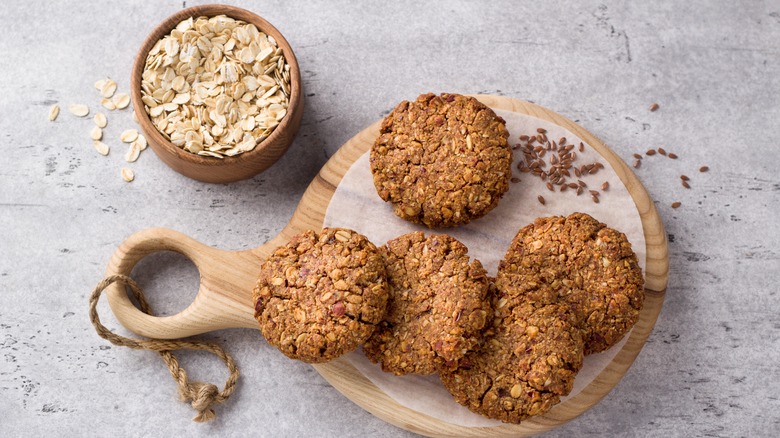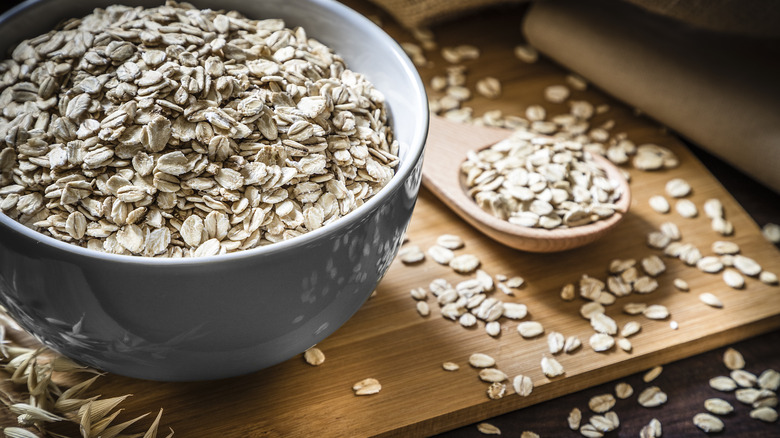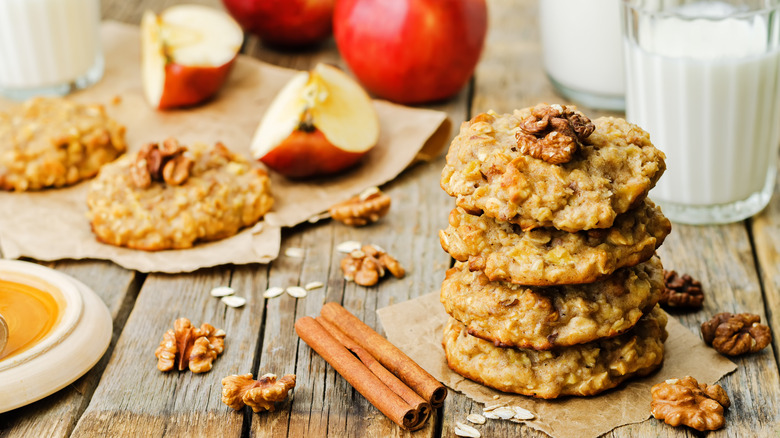The Best Type Of Oats To Use For Oatmeal Cookies
The age of widespread hate for oatmeal cookies should be over by now. These toothsome treats can be deeply satisfying and delicious, with a texture that's as craveable as that of chewy chocolate chip cookies. However, the best oatmeal cookies — ones that no one would call boring or disappointing — are all about using the right oats.
For instance, if you use instant oats, which have been processed to make them cook more quickly, your cookies could lack a hearty flavor or chewy texture. You could wind up with coarse, grainy treats with an empty taste. On the other hand, steel-cut oats are very chewy and tough. Cutting the oat kernels into smaller pieces is the only processing they undergo. You could use them in cookies, but you would need to take measures to soften them up, unless you like to give your jaw a workout.
All of this goes to say that the best type of oats to use in cookies is old-fashioned (or rolled) oats. Unlike steel-cut oats, old-fashioned oats are steamed and softened, but not as thoroughly as instant oats are. These oats are chewy, hearty, and flavorful without being too hard or soft, making them perfect for irresistible oatmeal cookies. If you don't have any on hand, however, and a cookie craving strikes, you can use other oats in a pinch.
Can you substitute one type of oats for another in cookies?
In the event that you don't have old-fashioned or rolled oats on hand, no need to worry. You can make do with instant oats or steel-cut oats, but you'll have to account for their different textures by adding extra steps to your recipe.
To use steel-cut oats, you'll need to either soften them by cooking the oats ahead of time or grinding them down in a food processor. You can also mix them into your dough and let it sit overnight so the oats can absorb moisture. You'll also want to reduce the liquids in your recipe, as even after softening, steel-cut oats are too solid to soak up as much moisture as rolled oats can. Even with these changes, cookies made with steel-cut oats may still have a grittier texture, but they'll work to satisfy your craving.
As for using instant oats in cookies, your problem will be the mushy texture the oats take on once baked. Because their structural integrity is greatly broken down by their preparation process, instant oats tend to clump together and absorb all the moisture in your dough, making for dense cookies. These oats will also bake much more quickly, so be sure to keep an eye on your cookies in the oven. You can make the best of the situation by adding a bit of extra milk or liquid to your recipe so the cookies don't end up too dry.
Instant oats provide room for flavor experimentation
Instant oats may not give your oatmeal cookies the best chewy and rich texture, but they do have a couple advantages over old-fashioned oats. For one, you might not like the usual chewiness of oatmeal cookies, so instant oats could offer a denser, more floury-textured cookie with less obvious flakes of oats.More exciting is the fact that instant oats come in countless flavors -– apple, cinnamon, maple, brown sugar, berries, and even chocolate. You can add flavor to your cookies in a snap without having to reach for extracts, spices, or cocoa powder.
Again, you'll have to modify your recipe so the instant oats don't make the cookies too dry, but once you've figured out a good formula, the possibilities are endless. Imagine Swedish oatmeal and chocolate cookies made with chocolate instant oats to emphasize the chocolatey goodness, or a basic cookie recipe enhanced with brown sugar oats for a dash of warm sweetness. None of this is to say you can't add flavorings to cookies that use old-fashioned oats, but just like how instant oats make a bowl of oatmeal much more quickly, they can also give you a faster shortcut to a batch of fresh cookies.



